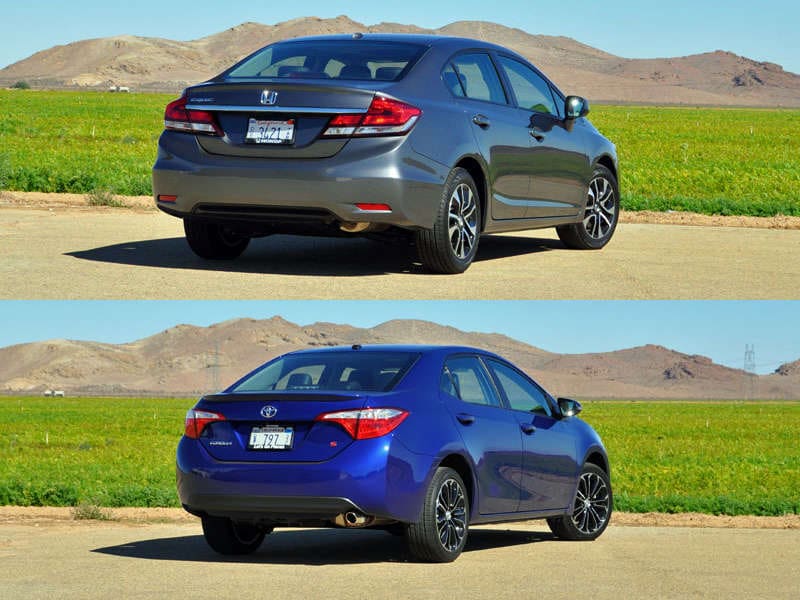Recent Articles
Popular Makes
Body Types
Back 2 Back Comparison: Honda Civic vs. Toyota Corolla
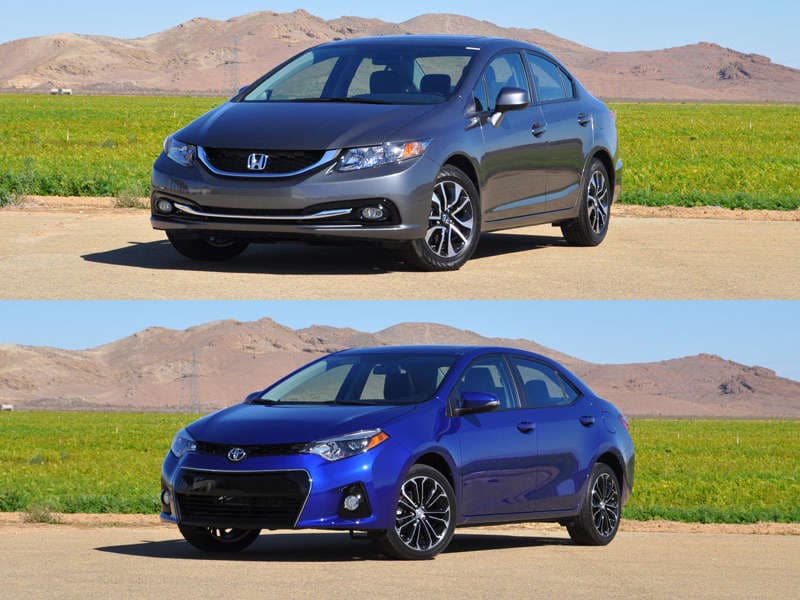
The two best-selling compact cars in America are the Honda Civic and the Toyota Corolla. At the halfway point in the current sales year, Toyota was 268 cars ahead* of Honda, which is statistically insignificant considering that together the two companies moved 317,676 Civics and Corollas from January to June. Viewed another way, one of every 25 cars sold in the U.S. is either a Civic or a Corolla.
Honda redesigned the Civic for the 2012 model year, and then promptly made substantial upgrades for 2013 in order to improve the Civic’s safety ratings, standard equipment levels, and overall refinement. After two steady years of upgrades, the 2014 model not significantly changed, continuing in 2-door coupe and 4-door sedan body styles, and available in base LX, upgraded EX, luxury-themed EX-L, fuel-efficient HF, hybrid-powered Hybrid, alternative-fuel Natural Gas, and performance-tuned Si trim levels.
For 2014, Toyota has completely redesigned the Corolla. The new Corolla is bigger inside, more fuel-efficient, and more sophisticated in terms of design and technology. Toyota has also cancelled the Matrix 5-door hatchback version for 2014, making all Corollas 4-door sedans available in base L, mid-level LE, fuel-efficient LE Eco, and sporty S trim levels.
I recently had an opportunity to drive the Civic EX-L Sedan and the Corolla S Premium back-to-back on the same 35-mile driving route and under the same weather conditions, and there are stark differences between these two popular cars.
* Sales figures include the Corolla-based Matrix model, but this version sells in low numbers
Back 2 Back Comparison: Honda Civic vs. Toyota Corolla -- By the Numbers
Evaluate a Honda Civic and a Toyota Corolla by the numbers, and the Toyota delivers the better value. Wearing a base price $1,345 lower than the Civic LX, the Corolla L is the less expensive car. The Corolla also has a larger interior with more front and rear seat legroom, and it has a bigger trunk. But it is heavier, less powerful, and not as well equipped in base trim as the Civic.
In order to compare the Civic and Corolla on relatively even footing from a standard equipment perspective, take a look at the Corolla LE. This model includes a continuously variable transmission (CVT), and still runs $645 less than a Civic LX with its optional automatic transmission. The Corolla LE lacks some of the Civic’s standard connectivity and safety features, but has LED headlights, automatic climate control and a 6.1-inch touchscreen radio display that aren’t included on the Honda. Plus, the Corolla LE’s lower price tag leaves room to add the Plus trim package to the car (fog lights, 16-inch alloy wheels, reversing camera) and still save $245 compared to the Civic.
When it comes to fuel economy ratings for the most popular engine and transmission combinations, the Civic and Corolla are evenly matched at 32 mpg in combined driving. For just $795* more, Toyota offers the LE Eco model for $19,905*, which is rated to return 35 mpg in combined driving. Honda charges $800 extra for the HF model, resulting in a High Fuel model wearing a window sticker reading $20,555 and 33 mpg in combined driving.
From a value standpoint, the Corolla is the better deal, and that’s before considering that it also comes with two years or 25,000 of free scheduled service. With the Civic, you’re paying for oil changes and tire rotations out of your own pocket.
* Corolla model availability is geographically variable. We used a suburban Detroit zip code to determine these figures. Local results may vary.
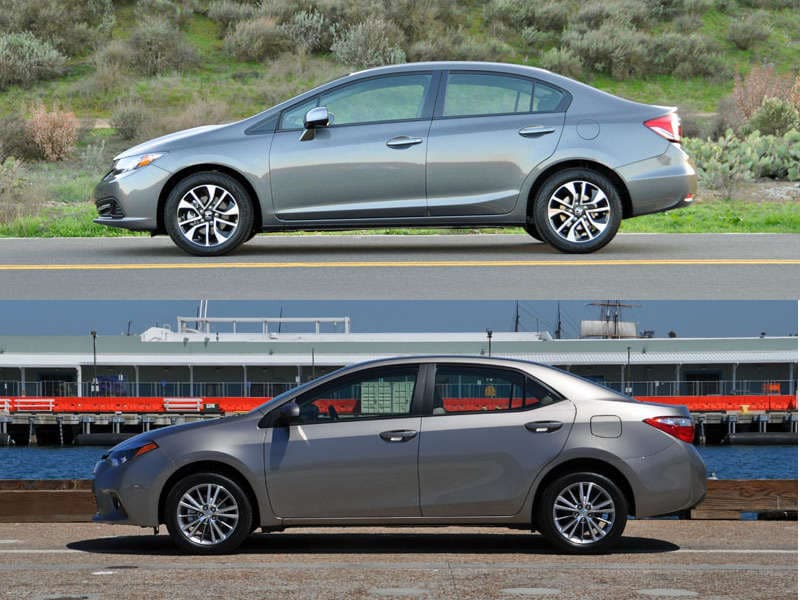
Back 2 Back Comparison: Honda Civic vs. Toyota Corolla -- Styling and Safety
Not only does the 2014 Corolla deliver superior value compared to the Civic, the Toyota is the better-looking car, too. It is to my eyes, anyway.
Starting in 2006, the Honda Civic displayed unusual, futuristic styling that ultimately became commonplace by virtue of the fact that millions of Civics were traveling American roads. When Honda redesigned the car for 2012, the Civic retained familiar themes but also lost some of its character, a situation Honda attempted to rectify with changes for the 2013 model year. The updates give the car a more upscale and robust appearance, but that doesn’t necessarily mean the car appears cohesive or appealing.
Cohesiveness and appeal are not problems for the Corolla, which is cleanly styled to Toyota’s new Iconic Dynamism design language. Riding on a wheelbase that is 1.2 inches longer than the Civic’s, the Corolla is also longer, taller, and wider than the Honda, and looks more modern and upscale. Choose the Corolla S model, and the Toyota gets more aggressive front-end styling. Trendy black 17-inch wheels with machined surfaces are included for the S Plus and S Premium versions.
With regard to safety, however, Honda’s got the Corolla beat. The Civic Sedan gets a 5-star overall crash-test rating from the National Highway Traffic Safety Administration (NHTSA) and a “Top Safety Pick +” rating from the Insurance Institute for Highway Safety (IIHS). One of the changes Honda made to the Civic for the 2013 model year was to install a more robust Advanced Compatibility Engineering II body structure, which is designed to better protect occupants in the types of crashes that the IIHS’s new small overlap frontal-impact test is designed to replicate: impact with a tree, utility pole, or oncoming vehicle on the left front corner of the car.
The new Corolla receives a “Marginal” score in the new small offset overlap frontal-impact test, which makes it ineligible for a “Top Safety Pick +” rating. This comes after Toyota told journalists gathered for the car’s launch that the automaker had made specific changes halfway through the redesigned Corolla’s gestation that were intended to address the new test, and that they predicted the Corolla would earn the top IIHS rating.
Given that “Marginal” rating, you can bet Toyota will be hustling to beef up the Corolla’s structure ASAP, so if you really want one, wait until the IIHS tests it again.
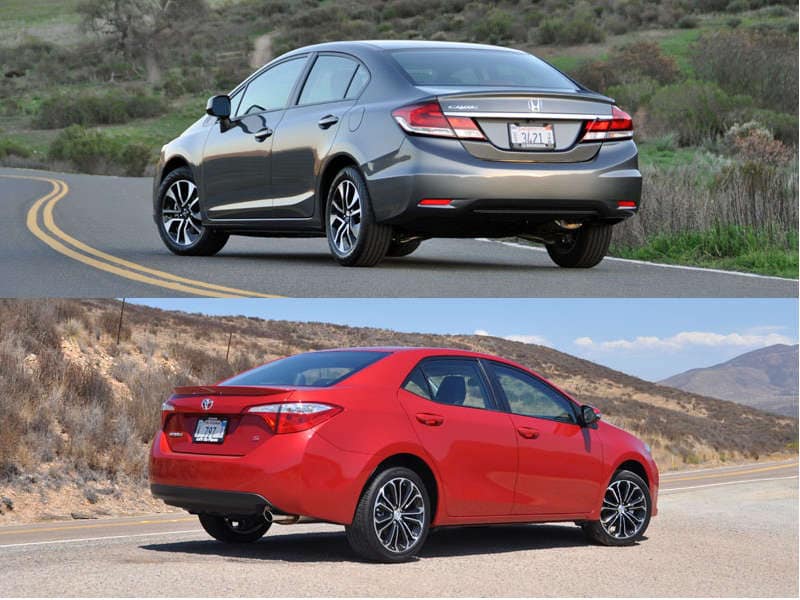
Back 2 Back Comparison: Honda Civic vs. Toyota Corolla -- Interior and Comfort
If the Honda Civic’s exterior styling has become more familiar and less polarizing over the years, its interior remains a shock to the system for the uninitiated. There’s nothing traditional about the way the gauges are displayed, or how the navigation, radio, and climate controls are located high and angled toward the driver. Twist the key, let the electronic displays come to life, and you’ll find that it all makes complete sense, and that all of the controls are exceptionally easy to find and use. Plus, with the changes made for the 2013 model year, the Civic’s cabin displays an impressive level of quality and refinement for a small and affordable sedan.
In contrast, the new Corolla’s interior is almost retro in appearance, with a flat, wide dashboard that appears to bow inward as it meets the door panels. The design lends a sense of spaciousness, and while it is busier than the Honda’s control panel, it also offers larger buttons and knobs for the touchscreen navigation and infotainment system, along with larger markings that are easier to read. Unfortunately, the Corolla’s screen suffered plenty of ambient glare during a mid-afternoon drive, whereas the Civic’s screen remained legible.
Both cars are comfortable. I prefer the Civic for front seat comfort, but if I drew the short straw and needed to ride in one of the back seats, I’d rather find myself in the Corolla. Astoundingly, the Corolla offers almost as much rear seat legroom as front seat legroom, which means it might just make a pretty awesome taxicab. This is not to say that the Civic’s rear bench amounts to a penalty box. But when a person who is six feet tall can cross his legs without coming into contact with the front seatbacks, as I can do in the Corolla, there’s simply no contest.
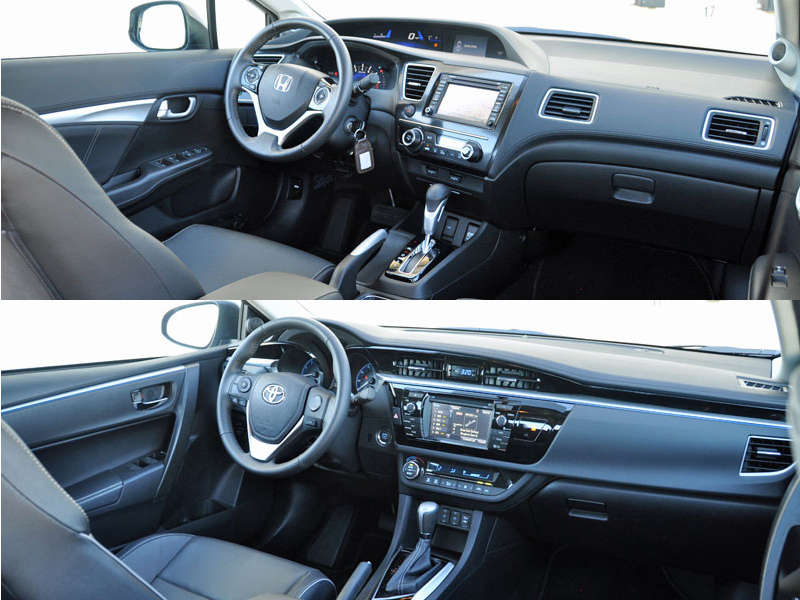
Back 2 Back Comparison: Honda Civic vs. Toyota Corolla -- Driving Dynamics
Here’s the great thing about Hondas. Every single one of them – even the aging Ridgeline pickup truck – is engineered to competently go, handle, and stop, displaying competence on a wide variety of road surfaces. There’s a reason the Honda Accord is a 25-year veteran of the Car and Driver “10 Best List,” and it’s not because the automaker sends regular thank-you checks to Ann Arbor.
The Civic is no different. From the moment you shift into gear, the Honda demonstrates remarkable responsiveness and refinement, effortlessly quick and agile in terms of driving character. This dynamic goodness is baked right in, even for the basic Civic LX model, and without pinpointing it as a specific reason for loving their cars, this athleticism helps to make Honda owners loyal to the brand. And if you’re looking for a genuinely affordable and dependable sport sedan, or a high-mileage hybrid model, Honda sells them in the form of the Civic Si and the Civic Hybrid. Toyota, not so much.
In comparison to the new Corolla, the most popular Civic models have more horsepower and weigh less, which helps to make them feel more vivacious from behind the wheel. The Honda’s 5-speed automatic transmission doesn’t drone like the Corolla’s CVT, and while that CVT is equipped with paddle shifters for the S trim level, they appear to be more adept at modifying the amount of noise created by the engine than at taking advantage of a power curve.
Furthermore, the Civic’s interior offers better isolation from wind and road noise, and the Honda’s standard independent rear suspension delivers superior ride quality and road holding compared to the Corolla. I also liked the Honda’s electric steering better, and the fact that all Civic models except for the base LX and the HF trim levels get disc rear brakes, while Toyota offers these upgraded components only on the top versions of the Corolla S.
Dynamically, there’s no contest. The Civic is the one I’d rather be piloting, whether from Point A to Point B or from Point Mugu to Provincetown.
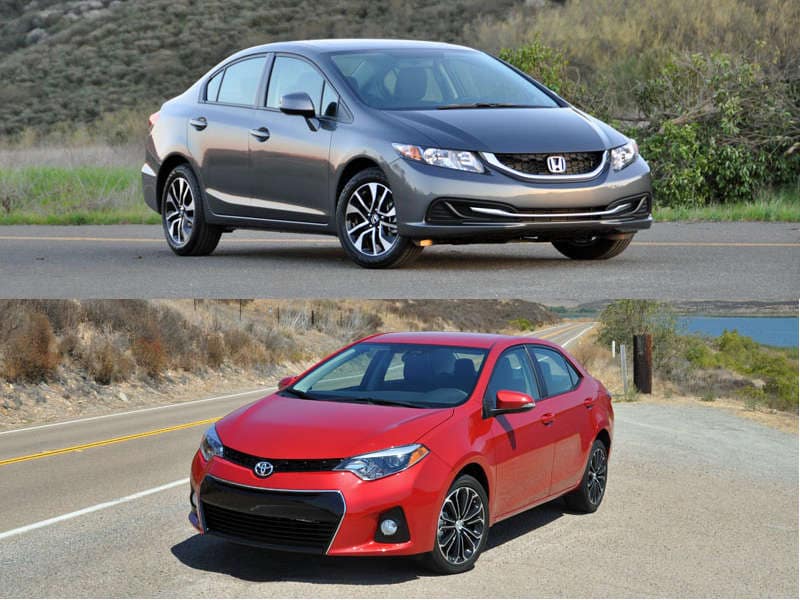
Back 2 Back Comparison: Honda Civic vs. Toyota Corolla -- Final Thoughts
When you take a close look at the Honda Civic and the Toyota Corolla, and you have the chance to drive them back-to-back, it is clear that each car has its merits. The Civic is the safer choice, offered in a greater variety of body styles and trim levels, and in my opinion is the more comfortable, refined, quiet, and engaging vehicle to drive.
That doesn’t mean the Corolla is unworthy of consideration. Completely redesigned for 2014, the Corolla is less expensive, larger inside, better looking, and technologically more sophisticated. And while Honda offers a dedicated performance model and a pricey hybrid model, Toyota makes high-mpg accessible with the LE Eco trim level.
My pick, however, would be the Honda, because I strongly value safety ratings, I enjoy driving it more, and it comes across as the better-engineered vehicle. Plus, the Civic Si is a real sport sedan, while the Corolla S is not. Unfortunately, the Honda isn’t nearly as good looking as the Corolla, is it?
The author drove the Civic and Corolla back-to-back at an event sponsored by the Motor Press Guild
Honda Civic and Toyota Corolla photos by Christian Wardlaw
